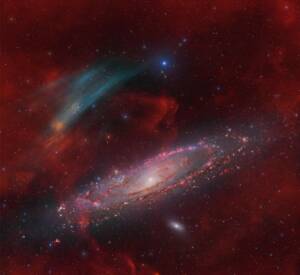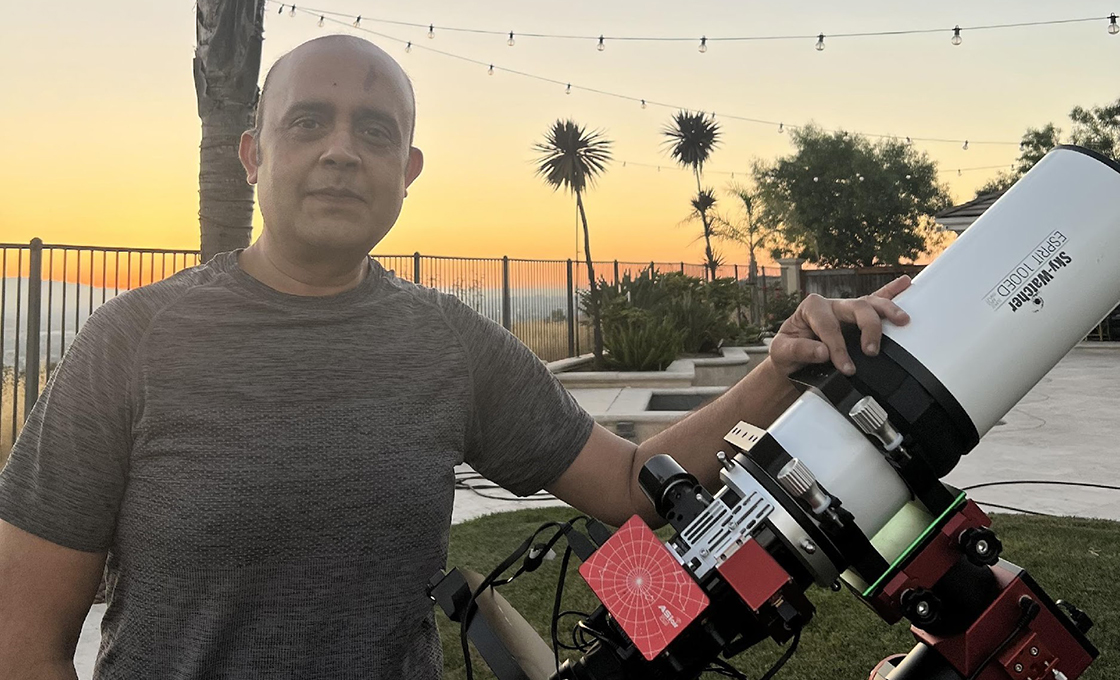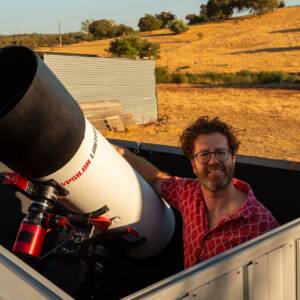
Discovery of the M31 [OIII] emission arc
Recently, a major discovery by an international team of amateur astronomers and scientists has become a huge online hit, and this new discovery is just located in one of the

Hello Imran, thanks for accepting our interview invitation. Congratulations on winning the ASIWEEK competition in week #39/2023!
Thank you so much for the recognition and hello to everyone. My name is Imran Badr, and I live in San Francisco Bay Area with my wonderful wife and three children. I am a technology manager during the day and sometimes during the nights as well but most of the time, I am catching photons after the sunset. I upload my Astrophotography work at https://www.astrobin.com/users/imranbadr/
I also have an Instagram account where I share my images: https://www.instagram.com/astrobayarea/


My love for the night sky started very early during my childhood. I was born and raised in Karachi, Pakistan where lived in its far suburbs with relatively darker sky. That was from early to late 1970s. My favorite time during the nights was to lay down on our rooftop under the open sky and look at stars. I had no idea of the constellations and I used to imagine different shapes by connecting stars. Once during those years, my father asked me and my siblings about our wish list for gifts at the end of fasting month of Ramzan. I remember my wish at that time was to have a telescope.
Sky always attracted me as a child and still today, I find night time sky the best way to unwind and relax.
I am very new to Astrophotography. Until late summer of 2022, I didn’t have any dedicated imaging camera and I had no idea about the equipment and steps involved in capturing and processing images. I had bought a Celestron Nexstar 6se telescope with AltAz mount back in 2015 but I only had used that rarely for observing the moon and planets. I did try once and captured one frame of Saturn. Back in 2019, we moved to our new house with a lot more sky available from my backyard. That prompted me to start researching about astrophotography. As a result, I bought my first equatorial mount ZWO AM5, Sky-Watcher Esprit 100Ed telescope, 7-filter Electronic Filter Wheel, ASI2600MC Pro camera, ZWO Off-Axis guider, ASI290MM Mini guide camera, ZWO ASIAIR Plus controller and a couple of Optolong narrow-band filters. Earlier this year, I bought a Celestron EdgeHD9.25 telescope, Sky-Watcher EQ6rpro mount and moved my ASI2600MC Pro to this new setup. I bought ASI2600MM Pro and Antlia 2.5nm narrow-band filters to use with AM5/Esprit100ed.
Lagoon nebula had been on my list ever since then. The challenge was its low elevation in the night sky and some palm trees blocking my view. I moved my scope/mount to the second-floor balcony to have an unobstructed view of southern sky. Due to the weather and clouds, I was only able to capture 3-4 hours of frames on Antlia 2.5nm Ha, S2 and O3 filters. I was blown away by the quality of ASI2600MM Pro camera. Just 3-4 hours of shooting per filter under bortle7 sky gave me very clean Ha, S2 and O3 with high SNR. I used Pixinsight for end to end processing of images. I was very careful in making sure that the image was not over-stretched and over-sharpened.

You can see a better resolution of this image at: https://astrob.in/01wz0m/B/
I have two imaging rigs:


That depends upon various factors such as number of frames and resolution. I have a pretty power machine with Intel I7 processor, 128GB RAM and 2TB NVME SSD. Stacking can take from an hour to several hours. Once stacking is done, then background extraction, color calibration, deconvolution and noise reduction, stretching, and color adjustments can take from a couple of hours to several hours. I have also learned to break my post processing work to multiple sessions over a couple of days. That gives me fresh perspective of the status at the beginning of each session. I don’t think that there is a one part more important than others. Every step requires careful understanding of the image and its needs.
I do most of imaging in my backyard under Bortle 7 sky. Air quality in my area is generally pretty good but during summers there could be smoke due to wild fires. The biggest challenge in my area is high humidity and evening/night fog and clouds. I sometimes travel to darker sky locations 3 hours to 8 hours away with my friends and family for imaging. It is fun experience to share this passion with others and spread the knowledge that I’ve acquired about astronomy and astrophotography.
My first astrophotography experience was back in 2015 when I was able to take one frame of Saturn using Celestron Nextar 6SE and a Canon DSLR. After that I couldn’t spend any time on Astrophotography until the late summer of 2022. I was extremely delighted to see that blurry image of Saturn. It was extremely exciting experience and I shared that image with friends and family.
My favorite celestial target has to be the Sombrero Galaxy. It was widely appreciated in the Astrophotography community. I was very happy when ZWO shared that image on social media.

I was always fascinated by the night sky. Astrophotography has allowed me to go deeper into the space and capture amazing objects. It is just amazing that we capture the very light that for most of objects are not visible to the naked eye. The feeling that I am capturing photons that travelled thousands and millions of light years and fall on the camera’s sensor. It is a window into the distant past and it adds a little extra ordinary to our daily lives. The entire experience of setting up the scope, precisely arranging the imaging train to be able to capture photos is a challenge and extremely satisfying experience.
Astrophotography opens up the window to the vastness of the universe. It makes me realize how small we are in the grand scheme of the Universe. It makes us appreciate the life and our home planet Earth. This is the only home we know where we can live and survive.

I rather have a funny story. I was shooting the Cygnus wall and after I had captured several hours of data, I noticed a small circle on my subs. That circle was clearly visible in all O3 frames and I started to think that it might be a small planetary nebula. I shared this with my family that I may have found something. I even asked some of my astro friends if there was a nebula near that field of view. I remained excited for a few days but when I looked at my flat calibration frames I realized that it was just a dust particle on my O3 filter. We had a good laugh at family dinner that night.
At the same time, I have been truly blessed by the amazing Astrophotography community. Multiple ZWO forums and CloudyNights have been my source to learn about this hobby. There are amazing members who are ready to help you in real time. Like anyone else, I also love to see positive comments and encouragements. I also receive constructive criticism which have helped me to learn and grow more. I was extremely delighted when ZWO shared my Orion Nebula image during Thanksgiving of 2022. I think that was my second even DSO object. I was extremely delighted, proud and pleased.
Orion Nebula imaged using ASI2600MC Pro:

Family is my love, Work is for our financial need and Astrophotography is my passion. I am extremely lucky to have an amazing supportive family. They support and encourage me to pursue my passion. They join me at times to darker sky sites.
Automation options available for Astrophotographers have enabled us to spend more time with family. I use ASIAir plus and Pro for all my automation needs. ASIAir is simple to use and intuitive user interface shortened the learning curve for me. Work is during day times and automation helps me during imaging time. I haven’t run into problems managing time between work, family and Astrophotography.
My main imaging cameras are ASI2600MM Pro and ASI2600MC Pro. I started off with the color camera because it was easier for me as a beginner. Once I became more comfortable with capturing frames using multiple filters and post-processing, I bought ASI2600MM Pro.
I also acquired ASI533MC Pro earlier this year and have taken some images that were liked by the community. Other than these three cameras, I have ASI174MM Mini and ASI290MM Mini cameras for guiding.
ASI2600MC Pro has been my main camera and have been very happy with its results. Below are some images which I captured using ASI2600MC Pro.
Horsehead and Flame Nebula. Taken from my backyard using ASI2600MC Pro. Higher resolution: https://astrob.in/6bdo6o/

LDN1251 taken from ASI2600MC Pro from Pinnacles National Park. Higher resolution: https://astrob.in/390hj7/B/

M45 taken from Death Valley using ASI2600MC Pro. Higher resolution: https://astrob.in/be1txy/B/

Crescent Nebula imaged using ASI533MC Pro. Higher resolution: https://astrob.in/m29kii/0/

I have been planning to spend a few nights under the Bortle1 sky of the Death Valley since Apr of this year. I had to cancel my plans during mid Aug due to the storm and flooding. I was planning to shoot some faint and dark objects. Due to that change, I started shooting sh2-119 (Clamshell Nebula) from my Bortle7 backyard. It is not very imaged very often and it seems like a great challenging object. I am post processing it these days and it is challenging to bring out the depth.
During next moon cycle, I am planning to travel a little darker sky (hopefully the Death Valley) and capture a few darker objects.

Recently, a major discovery by an international team of amateur astronomers and scientists has become a huge online hit, and this new discovery is just located in one of the

By day, David Cruz works as a digital designer. By night, he designs something far greater — images of the universe itself. “Since I was young, I was always interested

bbrown_admin, October 30, 2025 INITIAL IMPRESSIONS: The ZWO ASI585MC Air came well packaged from the manufacturer. The box is improved and has an impressive feel with a magnetic closure on

– Q3 ASIWEEK Winner Gianni Lacroce’s Astrophotography Journey Hi, I’m Gianni Lacroce, an Italian astrophotographer. My passion for the night sky began long before I owned a telescope or a

INTRODUCTION My name is Marzena Rogozińska. I live in Bytom (Poland) and work as a psychologist and pedagogue at two schools. I would like to thank you for honoring my

Two years after winning #44/2023, Robert Eder, a sound engineer from Vienna, Austria, has once again claimed victory with #27/2025 ASIWEEK, returning to share his astrophotography journey. Combining technical skill